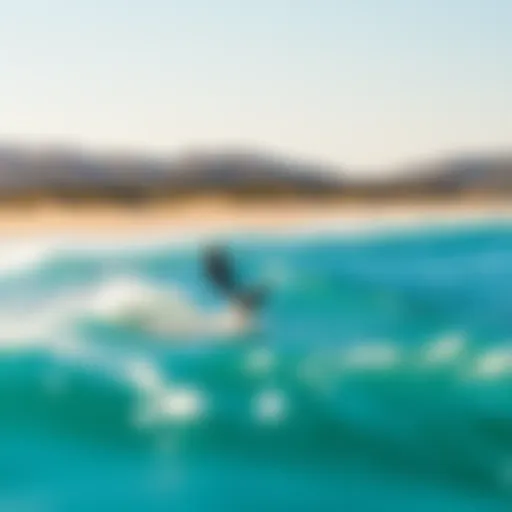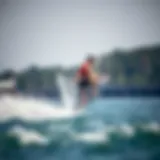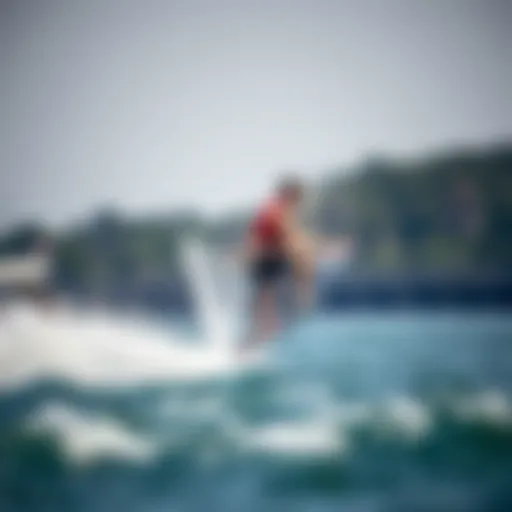Mastering the Slingshot Technique in Kiteboarding
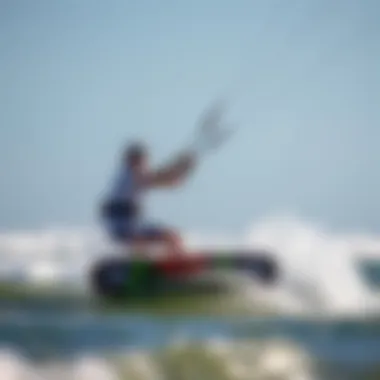
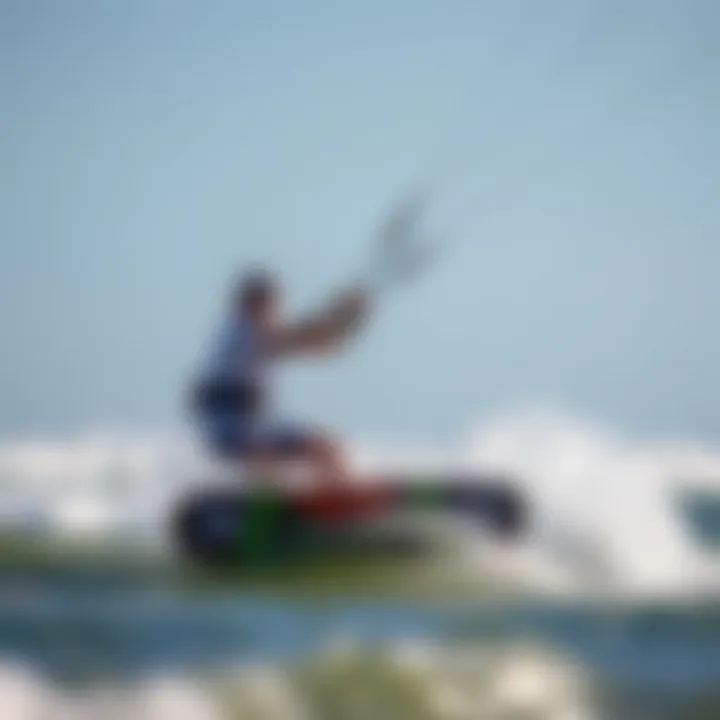
Intro
Kiteboarding is, without a doubt, one of the most exhilarating water sports out there. Among the myriad of tricks that kiteboarders aspire to master, the slingshot technique stands out as a game changer. This not just enhances performance but opens avenues for creativity and skill expression on the water. Kiteboarders know that what sets them apart is how they harness the wind to achieve that little extra push and flair in their movements. When referring to the slingshot maneuver, one often envisions the explosive burst that propels the rider to greater heights and thrilling speeds—all while dancing with the breeze.
So, what exactly does it take to become proficient in this advanced technique? This guide promises to illuminate the nuances ranging from essential techniques to the nitty-gritty of gear that can help refine your skills on the water. From beginners trying to get their footing to veterans seeking to push their limits, there’s something here for everyone. The goal is to demystify the slingshot technique and provide kiteboarding enthusiasts with in-depth knowledge that can transform their approach, both in practice and competition.
Let's dive right in and explore the essential techniques that pave the way for kiteboard enthusiasts seeking to harness the full potential of the ultimate slingshot.
Understanding the Slingshot Technique
The slingshot technique is a cornerstone of kiteboarding prowess, largely because it opens up a world of dynamic maneuvers possible on water. Kiteboarding is not merely about gliding but also involves executing tricks that show skill, control, and finesse. The slingshot is a technique that effectively utilizes both the dynamics of the kite and the rider's body to achieve exceptional height and speed.
Adopting this technique can significantly amplify consistency and overall performance on the water. Riders who grasp the slingshot maneuver often find themselves with an edge, particularly in competitive scenarios where every second counts. Enhancing the mastery of this method elevates the kiteboarding experience and allows kiteboarders to transition seamlessly into more advanced tricks with confidence.
However, understanding the slingshot is not just about achieving breathtaking jumps or tricks; it also includes comprehending the right conditions, equipment, and physical positioning that contribute to a successful slingshot. The following sections will dissect these vital aspects, aiming to equip you with comprehensive insights that are essential for mastering this fundamental kiteboarding technique.
Defining the Slingshot in Kiteboarding
At its core, the slingshot in kiteboarding is a method where the rider harnesses the kite's pull dynamically to launch off the water. Think of it like a slingshot: you stretch the rubber band back, and when you release it, the energy snaps back, propelling whatever is in it forward at speed. In kiteboarding, this means pre-loading the kite while on the water, then releasing that stored energy to boost yourself into the air.
The timing and angle of the kite relative to the wind are crucial. Riders must be attuned to the kite's position to effectively execute the maneuver. The slingshot isn't just a trick; it's a critical method that emphasizes energy transfer in kiteboarding. Having a firm grip on your body mechanics and kite dynamics during this maneuver can lead to improved performance and greater safety on the water.
The Physics Behind the Slingshot
Understanding how physics intertwines with the slingshot maneuver is paramount for kiteboarders seeking to excel. Essentially, it involves the transformation of potential energy into kinetic energy. When a rider leans back, applying tension to the lines, they're essentially increasing the kite's angle against the wind, thereby generating lift.
As the rider prepares to slingshot, a few physics concepts come into play:
- Lift: As wind flows over the kite, it creates lift, raising the kite and the rider into the air.
- Drag: This is the resistance faced as the rider moves through water. Riders must manage drag through body position and board choice to harness the most from their slingshot.
- Thrust: This comes from the kite’s pull. By timing when to pull on the lines and release weight, riders can maximize thrust to gain altitude.
Properly applying these dynamics will not only enhance performance but also minimize the risk of miscalculations leading to falls or injuries. Hence, comprehending the relationship between these elements is critical for any kiteboarder wishing to refine their slingshot technique.
"The slingshot maneuver is as much about understanding nature's forces as it is about the rider's skills. The two dance together on the water, weaving a tapestry of athleticism and physics."
Delving into the slingshot technique's intricacies not only augments the kiteboarding experience but also sets the groundwork for a host of advanced skills. As kiteboarders refine their techniques, they essentially write their story of prowess and skill in the fluid dynamics of water and air.
Equipment Essentials for Executing the Slingshot
Getting the hang of the slingshot maneuver is not only about technique; the right gear plays an incredible role too. Having the correct equipment is sort of like having the right tools in your toolbox—it can mean the difference between pulling off sick moves and just flopping around. The right kite, board, and harness all contribute to the slingshot’s effectiveness and can elevate your performance, making this section essential for anyone looking to master this advanced kiteboarding technique.
Choosing the Right Kite
When it comes to kiteboarding, your kite is your lifeline—maybe even more than that, your kite is your ticket to unlocking intricate maneuvers like the slingshot. It’s crucial to pick a kite that responds well to your movements, and one that’s suitable for the wind conditions you’re typically riding in.
- Size Matters: The size of your kite can dictate how quickly you can generate power. A larger kite will catch more wind but can be harder to handle in gusty conditions. Conversely, a smaller kite is easier to control but necessitates stronger winds to perform well.
- Type of Kite: Not all kites are born equal. If you’re focusing on the slingshot maneuver, look into wave kites or freestyle kites as they are generally designed for versatility and agility.
- Flexibility and Speed: Some kites allow for quick turns and can pull you faster, which can be essential when performing the slingshot. Pay attention to the bridle system as well, as it impacts how your kite flies.
The Importance of Board Selection
Once you’ve got your kite sorted out, the next piece of the puzzle is your board. Remember, your board is what connects you to the water, and not all boards come equipped for the slingshot maneuver. The float and rocker shape can seriously affect your capability to launch off the water during a slingshot.
- Board Type: Freestyle boards often have a stiffer flex and are typically shorter. They help in pop and quick tricks. If you're on a freeride board, make sure it offers a good edge grip.
- Volume and Shape: A board with more volume can assist in staying afloat and can make transitions smoother. A concave shape might also help in cutting through the water quickly, allowing you to generate speed for that ideal slingshot.
- Bindings: The positioning and style of bindings can impact comfort level during high-speed maneuvers. Make sure your feet are snug but comfortable, allowing you to still have some range of motion while keeping control.
Harness Options and Their Impact
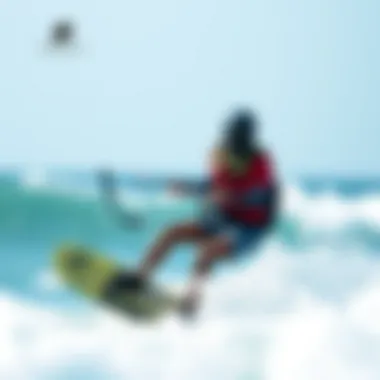
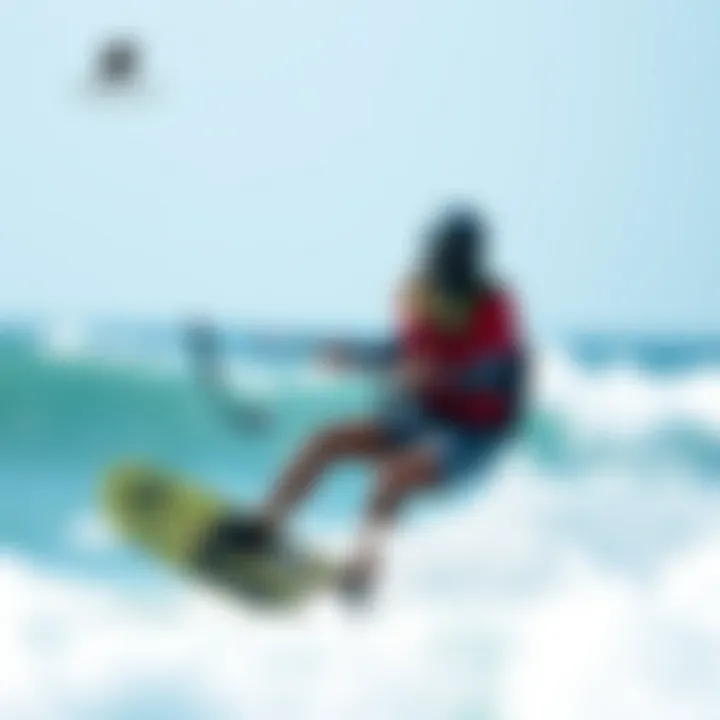
The harness is not just a belt; it’s a support system that can enhance your performance significantly. Choosing the right harness can transform your riding experience and can even help you improve your slingshot execution.
- Types of Harnesses: Generally, you’ll find two types—waist harnesses and seat harnesses. The waist harness gives you more freedom of movement, which is beneficial when you’re trying to perform tricks. A seat harness, on the other hand, can offer more support, especially for beginners.
- Fit and Comfort: A good harness should fit snugly without pinching or restricting movement. Look for designs that allow for an easy adjustment (like a quick-release mechanism) so that you can find the perfect fit every session.
- Foam Padding: Don’t underestimate the importance of padding in your harness. More padding means better support and reduced fatigue, allowing you to focus on nailing that slingshot.
Remember, the foundation of an impressive slingshot maneuver often relies on the synergy between your kite, board, and harness. Invest the time and effort to find the right equipment, and you’ll see your performance soar!
By paying attention to these equipment essentials, you'll set yourself up for success on the water. Each piece is an opportunity to refine your technique and enhance your overall kiteboarding experience.
Executing the Ultimate Slingshot Maneuver
Executing the ultimate slingshot maneuver is pivotal in mastering kiteboarding. This technique can elevate a rider's performance significantly, enabling them to harness the wind's power more effectively than ever. Perfecting this maneuver allows kiteboarders not only to gain speed but also to showcase their skills in a thrilling way. The slingshot sets the stage for a range of tricks, making it an essential skill for any serious kiteboarding enthusiast.
Pre-Execution Preparations
Preparation before executing the slingshot is almost like preheating the oven before baking; it’s essential. Adequate assessment of conditions is paramount. Check the wind direction and speed. A consistent wind can mean the difference between success and avoiding a faceplant in the water.
Consider adjusting your gear setup. A well-tuned kite, suitable for the day’s conditions, is an asset. If the kite's size doesn’t match the wind conditions, executing the slingshot becomes trickier. Moreover, visualizing the maneuver's trajectory in your mind can boost confidence and readiness.
Step-by-Step Guide to Execution
Setting Up Your Position
Setting up your position is like laying the groundwork for a sturdy building; it's the foundation of your maneuver. Positioning yourself correctly influences balance and control significantly. Bend your knees slightly; this lower center of gravity will help maintain stability.
A vital aspect is the kite’s location in the wind window. Ideally, you will want your kite above your head. This helps generate maximum lift without overwhelming you. Remember, though, this setup may require a little practice. Ideally, a balanced stance allows quick adjustments during the maneuver, enhancing overall responsiveness to the wind.
Timing Your Pull
Timing your pull is another crucial part of this maneuver. It’s all about finding that sweet spot just as the kite reaches the zenith of its arc. Pull too early, and you risk misalignment; pull too late, and you won’t maximize the thrust.
The optimal moment varies based on wind conditions and personal style. A well-timed pull can deliver a jolt of acceleration as you transition from a stationary position to dynamic movement. Practicing timing can often lead to a smoother experience, reducing the likelihood of mistakes that might lead to capsizing.
Controlling Speed and Trajectory
Controlling speed and trajectory is the third leg of the slingshot tripod. After launching into motion, regulating your speed is crucial to avoid losing control. As you gain speed, shifting your weight correctly will guide your board in the desired direction.
Effective control involves being mindful of the kite’s position in the wind window. The kite should be subtly adjusted to ensure that you maintain the appropriate angle against the wind. Excess speed can also be counterproductive, so learning to balance acceleration with stability is essential to maneuver effectively.
Post-Execution Control and Recovery
Once the slingshot is executed, your work is far from over. Maintaining control post-execution ensures a seamless transition into what comes next—be it another trick or simply cruising. Focus on your body positioning and keep your eye on the horizon to maintain balance.
Recovery is about quickly understanding how to redirect power from the kite while also making any necessary adjustments. Should you encounter turbulence, knowing how to respond will minimize any mishaps. It’s crucial to have a plan for both successful execution and unanticipated situations.
"Preparation, precision, and control are the trifecta that holds the key to mastering the ultimate slingshot."
In summary, mastering the execution of the slingshot maneuver involves diligent preparation, precise timing, and skilled control post-maneuver. Equipped with this knowledge will undoubtedly enhance your kiteboarding prowess, allowing you to make the most of each wave and wind gust.
Common Pitfalls in the Slingshot Technique
Understanding the slingshot is only half the battle; mastering it requires avoiding common pitfalls that can derail your performance or make for a less enjoyable experience on the water. Recognizing the obstacles that can occur during execution can pave the way toward honing your skills. Each misstep often stems from a few central mistakes that capture the attention of seasoned riders and beginners alike. Addressing these mistakes is essential, as they can significantly impact the height you attain, the speed you generate, and the overall control you maintain during the maneuver.
Identifying Common Mistakes
As kiteboarding enthusiasts, we often learn from the school of hard knocks. Here are several frequent mistakes that plague riders attempting the slingshot:
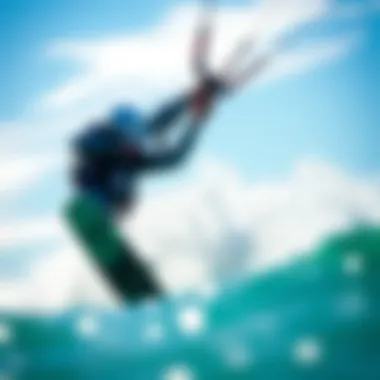
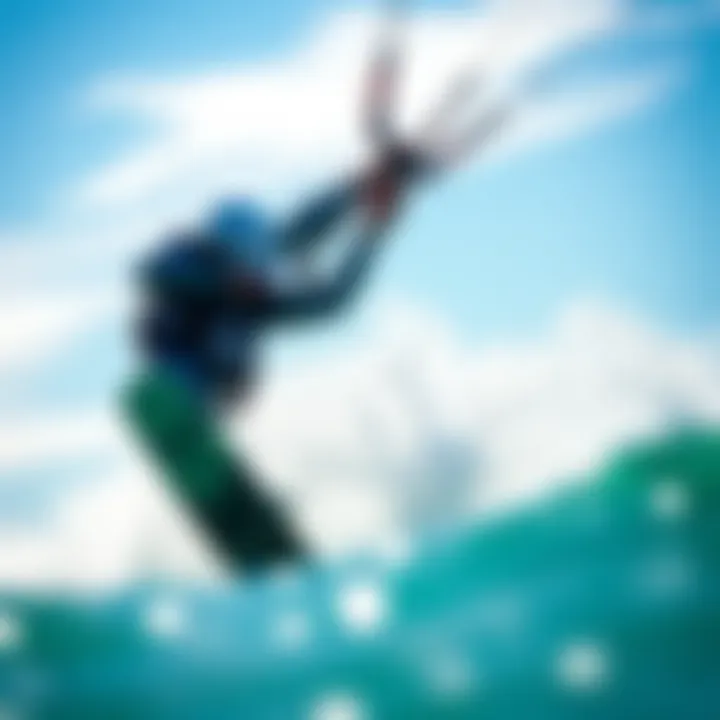
- Poor timing of the kite: Timing is crucial. Pulling too soon or too late can lead to a lackluster slingshot or even accidents. A well-timed tug on the bar when the kite is in the right position results in maximum lift.
- Inadequate body positioning: Your posture matters more than you might think. A slumped back or overly tense legs can throw off your balance. Instead, keep your knees slightly bent and your back straight to allow for proper weight distribution.
- Overlooking the wind conditions: Understanding the wind can make or break your slingshot. Riding in gusty conditions or varying wind angles without proper adjustments might lead to unpredictable outcomes.
- Neglecting to adjust the line length: If your lines are too long or too short, it makes executing the slingshot tricky. Proper line length tailored to your kite and riding styles provides better control.
Recognizing these pitfalls allows you to develop strategies that can alter your approach to kiteboarding gracefully.
Troubleshooting and Solutions
When faced with challenges during the execution of the slingshot, solutions often stem from experience and adaptation. Here are some proven strategies to remedy the aforementioned mistakes:
- Mastering timing with practice: Use practice runs to focus solely on timing. A great drill is to repeat the slingshot movement without launching, getting comfortable with the rhythm of the kite.
- Improving body mechanics: Take the time to practice balance drills off the water. Exercises like yoga or even balance boards can sharpen your awareness of body position, preparing you for the real thing.
- Understanding and adjusting to wind: Spend time familiarizing yourself with local spot forecasts and wind patterns. Keeping a journal of wind conditions during your sessions can help develop your intuition over time.
- Learning about equipment adjustments: Consult manufacturers’ specifications or community forums to determine optimal line length for kite types. Adjusting your equipment before practice sessions can lead to smooth sailing.
“Every mistake is a lesson learned; every lesson learned is one more step towards mastery.”
In essence, a combination of awareness, practice, and adaptability can turn stumbling blocks into stepping stones. Avoiding pitfalls in the slingshot technique not only boosts your confidence but also enriches your overall kiteboarding experience. For more guidance and community insights, consider visiting forums like reddit.com/r/Kiteboarding or engaging with enthusiasts on platforms like Facebook.
Ideal Locations for Slingshot Practice
Finding the right place to practice slingshot kiteboarding is crucial for both beginners and seasoned kiteboarders. Selecting ideal locations can significantly affect not only the execution of the maneuver but also safety and overall enjoyment. The experience goes beyond just the wind and water conditions; it also involves the environment, the skill level of the riders present, and the availability of necessary amenities.
When kiteboarding, factors like wind direction, water type, and local regulations come into play. Practicing in an optimal location allows you to refine your slingshot technique without the constant worry of obstructions or dangerous conditions. Furthermore, having access to other kiteboarders can foster camaraderie, providing valuable insights and tips, making your kiteboarding journey much more fulfilling.
Whether you’re after buzzing spots known for their strong winds or hidden gems tucked away from the crowd, the adventure begins with scouting the right environment to catch that ideal wind.
Top Spots Around the World
- Cape Town, South Africa
Renowned for its breathtaking scenery, blustery winds, and reliable waves, Cape Town attracts kiteboarders from all over. The Atlantic Ocean offers expansive areas for slingshot practice, especially at spots like Bloubergstrand, where the wind consistently blows at an optimal strength. Here, enthusiasts dive into the slingshot maneuver with a magnificent backdrop of Table Mountain. - Hood River, Oregon, USA
Hood River is celebrated in kiteboarding circles for its diverse wind conditions and vibrant community. In the Columbia River Gorge, the river’s current paired with powerful winds creates a perfect setting for practicing slingshots maneuvers. The consistent wind allows kiteboarders to harness their skills while enjoying the stunning vistas surrounding the area. - Tarifa, Spain
Considered the kitesurfing capital of Europe, Tarifa boasts a wide stretch of coastline with varying conditions ideal for all skill levels. With both Levante and Poniente winds blowing, practicing slingshots amidst the beautiful Andalusian backdrop will surely elevate your skills to the next level.
Local Secret Locations
- Kite Beach - Mui Ne, Vietnam
This lesser-known location offers fantastic wind and serene waters perfect for slingshot practice. With the rising sun casting a glow over the clear waters and the wind often blowing throughout the day, beginners can ease into their slingshot moves while the more experienced can take to the air without needing to compete for space. - The Strand, Queensland, Australia
This quaint coastline might not be on every kiteboarder's radar, but it offers a seamless experience for executing slingshots. The combination of soft sand, shallow waters, and strong winds ensures practice sessions can go uninterrupted. Locals often share tips that can help elevate your technique.
"The best kitesurfing spots aren’t always the most popular. Seek out local knowledge, and you might just stumble upon the next perfect slingshot venue."
- Ceneviz Beach, Turkey
A fantastic option, this spot is less crowded than more famous locations but still offers exceptional wind conditions conducive for practicing slingshots. The picturesque beach environment encourages a focus on technique without the typical distractions of more popular areas.
Enhancing Performance Through Advanced Techniques
In kiteboarding, understanding the intricacies of advanced techniques can transform a regular outing into a thrilling achievement. Enhancing performance is not merely about mastering the slingshot maneuver but also about refining diverse skills that complement kiteboarding. By delving deep into various advanced techniques, riders can boost their efficiency and finesse on the water. This guide aims to provide readers with a roadmap of sorts—one that leads them through the nuances of exhibiting performance excellence.
Linking Slingshots with Other Tricks
Combining slingshots with additional tricks provides a creative dimension to kiteboarding. When riders link the slingshot with maneuvers like jumps, spins, or transitions, it elevates the overall experience, adding flair and complexity. Each trick demands precise timing and control, so achieving a seamless transition between them can be a game-changer.
- Dynamic Flow: Performing a slingshot into a jump ensures that you maintain momentum. This fluidity can make any performance look smooth and rehearsed.
- Coordinated Movement: When engaging in a slingshot, it’s essential to coordinate your body movements with your kite's pull. This can make linking other tricks less cumbersome and more instinctive.
- Innovation in Style: Mixing in well-timed tricks while executing a slingshot presents an opportunity to showcase unique styles. Riders often make their mark not just through perfect execution but also through originality.
Effectively, the more tricks you have in your arsenal, the more dynamic your performance can be, enticing spectators and judges alike during competitions.
Using the Slingshot for Competitive Advantage
In a competitive setting, every small detail counts. The slingshot trick, when executed correctly, can provide a significant edge over competitors. Here’s why mastering this technique can put you a step ahead:
- Increasing Speed and Lift: The slingshot maneuver is known for its potential to gather speed quickly. By leveraging this technique, riders can increase their lift, enabling them to land higher jumps or perform advanced tricks successfully.
- Strategic Positioning: A well-timed slingshot can assist in moving towards less crowded areas of the water, allowing for a more favorable setup for executing tricks without interference from other riders.
- Judges’ Eye: Competitions often look for riders who can innovate while integrating different techniques. A slingshot can highlight a competitor's technical skill and grace, thereby making a lasting impression on the judges.
An adept use of the slingshot not only reflects skill but can also bolster a rider’s score, making it a pivotal element in competitive kiteboarding.
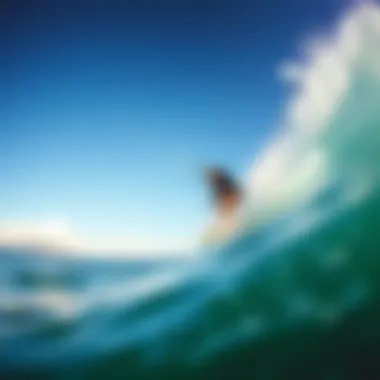
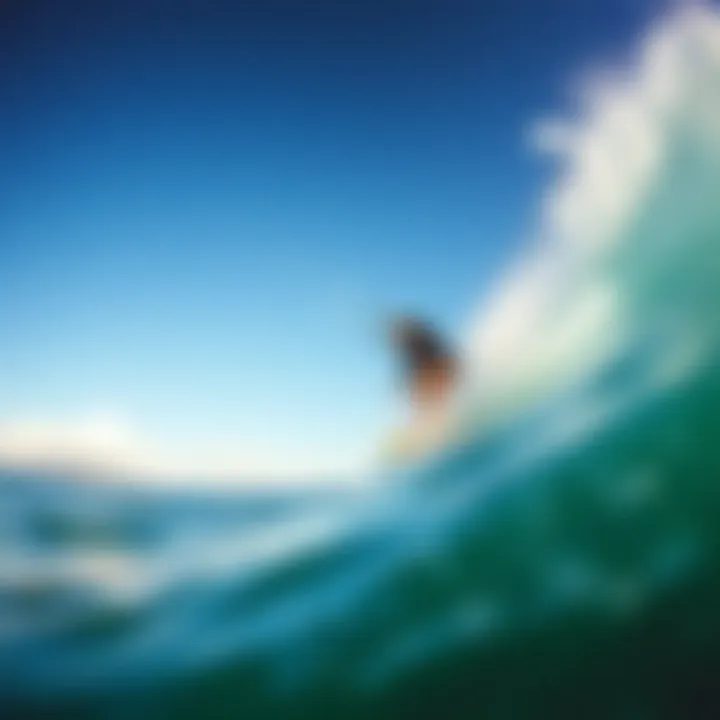
By integrating the slingshot with varied kiteboarding tricks and using it to gain a competitive edge, kiteboarders can significantly enhance their performances. The learning curve might be steep, but the rewards are well worth the effort. In the ever-evolving world of kiteboarding, staying on top of one’s game demands continual practice and a willingness to experiment with new techniques.
The Role of Community in Kiteboarding
Connecting with others transforms individual kiteboarding experiences into a rich tapestry of shared knowledge and passion. The kiteboarding community acts as a lifeline, where seasoned riders and newcomers alike come together, exchanging tips, advice, and stories that elevate the sport to new heights. This subsection explores how community involvement enhances skills, builds camaraderie, and boosts overall enjoyment for kiteboarders at any level.
Sharing Knowledge and Experiences
In the world of kiteboarding, sharing knowledge is like trading valuable currency. Each person has a unique story—those moments spent mastering a trick or surviving an unexpected tumble can offer profound lessons. By recounting their experiences, kiteboarders foster an environment where learning becomes continuous and collaborative.
- Mentorship Opportunities: Experienced kiteboarders can mentor newcomers, providing guidance on technique, safety, and gear selection. Having a mentor can significantly shorten the learning curve.
- Community Events: Organized meetups or workshops allow enthusiasts to gather, deepen their skills, and participate in friendly competitions. These events not only build skills but also strengthen bonds among participants.
- Real-Time Feedback: Riding alongside others opens the door for instant feedback. Peers can suggest adjustments on the spot, leading to rapid improvement and gaining confidence while riding.
"The best moments in kiteboarding happen when you share the stoke with others. Riding is fun, but riding together creates memories and bonds that last a lifetime."
Participating in Kiteboarding Forums
Online forums represent a cornerstone of the kiteboarding community, bringing together individuals from around the globe. Platforms such as Reddit or specialized kiteboarding websites allow enthusiasts to chat, post inquiries, or share instructional videos. These digital spaces create a network that transcends local boundaries, enriching the sport through diversity.
- Knowledge Exchange: Forums are invaluable for exchanging tricks, gear recommendations, or even discussing the latest innovations in kite technology. A simple search can unearth advice on everything from wind conditions to accident prevention.
- Building Relationships: Engaging in discussions can lead to friendships that extend beyond the screen. Meeting up with forum members at a kiteboarding destination can turn virtual relationships into real-world connections.
- Resource Hub: Many forums compile vast archives of user-generated content, including tutorials or gear reviews. This makes it easy to access a wealth of information, tailored to specific interests within kiteboarding.
As kiteboarding practitioners tap into the community's knowledge and support, they enrich their own journeys on the water. Understanding that you’re part of a larger family can be immensely motivating, inspiring kiteboarders to hone their skills and explore new horizons.
Future of Kiteboarding Maneuvers
Kiteboarding is evolving at a brisk pace, and the future of its maneuvers promises to be equally exhilarating. As kiteboarding enthusiasts, it’s crucial to keep an eye on upcoming techniques and innovations. These changes can redefine how we engage with the sport, improving performance and offering more creativity on the water. Understanding these advancements allows riders to enhance their skillsets, remain competitive, and explore new dimensions of this thrilling activity.
Innovations in Technique and Equipment
The future of kiteboarding is not just about flashy moves or tricks; it’s about refining techniques and enhancing equipment to make the sport more accessible and enjoyable.
Enhanced Kite Designs
With advances in materials and aerodynamics, manufacturers are producing kites that are more responsive and versatile. Increased efficiency in kite shapes allows for better lift and control, giving riders the confidence to attempt complex maneuvers, including the slingshot technique.
Smart Tech Integration
Imagine kites equipped with sensors that could provide real-time data on wind speed, altitude, and board speed. This kind of technology can facilitate personalized training, helping riders adapt to changing conditions swiftly. Wearable tech, too, could track performance metrics, allowing for better targeted skill improvement.
New Riding Styles
The fusion of different water sports could shape new riding styles and techniques. Skateboarding's influence is creeping in, with moves that incorporate elements from snowboarding and surfing. Riders are already experimenting with hybrid grips and stances, blurring the lines of traditional kiteboarding.
"Innovation is key to progress; those who adapt will thrive in changing waters."
Sustainability Practices in Kiteboarding
As we look to the future, it’s vital to examine sustainable practices within kiteboarding. The environmental impact of our sport could dictate its longevity and appeal to future generations.
Eco-friendly Materials
Many brands are beginning to utilize sustainable materials in kite and board production. Recycling plastics and biopolymers help lessen our footprint on the environment while maintaining performance levels. Buyers increasingly favor companies that are committed to reducing waste and promoting eco-friendly practices.
Responsible Riding
Location matters; being aware of protected areas and marine life is essential. Kiteboarders must embrace a culture of respect towards nature. Promoting responsible riding habits, like avoiding sensitive ecosystems and keeping noise levels in check, has become a priority.
Community Initiatives
Local kiteboarding communities show they care through organized clean-ups and environmental awareness campaigns. This active participation not only raises awareness but cultivates camaraderie among riders motivated to preserve their favorite spots. Programs fostering education around marine conservation can also build a more sustainable mindset within the kiteboarding community.
In summary, staying ahead of the game means embracing these innovations while being cognizant of our environmental responsibilities. The future of kiteboarding maneuvers will hinge on our ability to blend creativity with sustainability, ensuring this sport thrives for generations to come.

